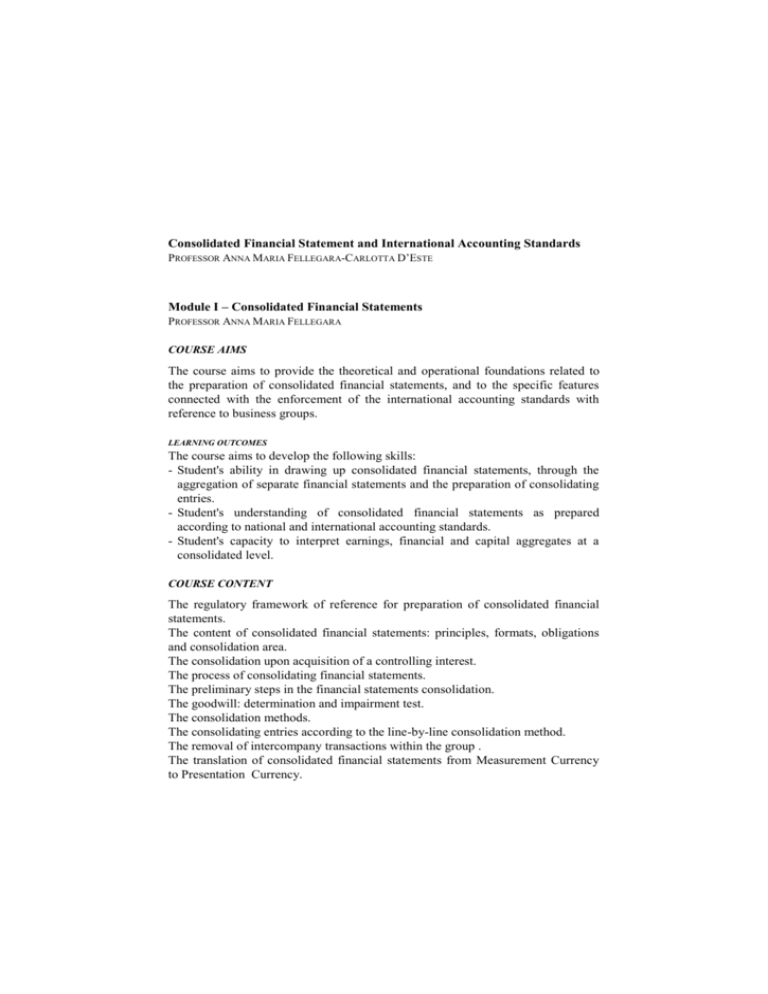Document
advertisement

Consolidated Financial Statement and International Accounting Standards PROFESSOR ANNA MARIA FELLEGARA-CARLOTTA D’ESTE Module I – Consolidated Financial Statements PROFESSOR ANNA MARIA FELLEGARA COURSE AIMS The course aims to provide the theoretical and operational foundations related to the preparation of consolidated financial statements, and to the specific features connected with the enforcement of the international accounting standards with reference to business groups. LEARNING OUTCOMES The course aims to develop the following skills: - Student's ability in drawing up consolidated financial statements, through the aggregation of separate financial statements and the preparation of consolidating entries. - Student's understanding of consolidated financial statements as prepared according to national and international accounting standards. - Student's capacity to interpret earnings, financial and capital aggregates at a consolidated level. COURSE CONTENT The regulatory framework of reference for preparation of consolidated financial statements. The content of consolidated financial statements: principles, formats, obligations and consolidation area. The consolidation upon acquisition of a controlling interest. The process of consolidating financial statements. The preliminary steps in the financial statements consolidation. The goodwill: determination and impairment test. The consolidation methods. The consolidating entries according to the line-by-line consolidation method. The removal of intercompany transactions within the group . The translation of consolidated financial statements from Measurement Currency to Presentation Currency. The changes in the consolidation area. The equity method. The proportional consolidation. The first time adoption of IAS/IFRS in consolidated financial statements. Several analyses of IAS/IFRS consolidated financial statements: overview. READING LIST A. PRENCIPE-P. TETTAMANZI, Bilancio consolidato. Tecniche di redazione e di analisi, 2011, Egea, Milan. Considering the continuous evolution of the International Accounting Standards, the related textbook will be suggested at the outset of the course. Professor's lecture notes. TEACHING METHOD Lectures on theory and assignments in class. ASSESSMENT METHOD The exam consists of a written test. Students can meet Professor Fellegara with on the days and at the times indicated on the Faculty notice board. Modulo II – International Accounting Standards PROFESSOR CARLOTTA D’ESTE COURSE AIMS The course deals with the topic of the international harmonisation of accounting standards and practices, highlighting the currently under way process of convergence between IASB and FASB. The course starts with introducing the current international scenario with respect to the central role of financial statement information in the pursuit of market efficiency. Then the supranational organisations involved in accounting regulation and the functions carried out by such organisations will be reviewed, with particular reference to the International Accounting Standards Board. The lesson plan also includes the analysis of the International Accounting Standards (IAS/IFRS) that are more relevant when compared with Italian national practices. LEARNING OUTCOMES - An understanding of the theoretical framework and of the evaluation criteria contained in the International Accounting Standards, with specific regard to the IAS/IFRS. - The capacity to prepare the financial statements of a trade/industrial firm, on the basis of International Accounting Standards, and to read and understand the results of either separate and consolidated financial statements, drawn up on the basis of International Accounting Standards, while sizing their key critical items. COURSE CONTENT 1. The process of international harmonisation of accounting standards and practices. Convergence and differences between international accounting systems. The role of the European Union in the process of international harmonisation of accounting standards and practices. The organisations involved in international accounting regulation. IASB: membership, functioning and historical development. 2. The sources of the International Accounting Standards. The IASB's Conceptual Framework. The connection with US GAAP: overview. EU directives and International Accounting Standards for the preparation of consolidated and separate financial statements. 3. Analysis of some IAS/IFRS. - Framework for the Preparation and Presentation of Financial Statements. - IFRS 1 - First-Time Adoption of International Financial Reporting Standards. - IFRS 8 - Operating Segments - IAS 1 - Presentation of Financial Statements. - IAS 2 - Inventories. - IAS 7 - Statement of Cash-flows. - IAS 11 - Construction Contracts. - IAS 16 - Property, Plant and Equipment. - IAS 17 - Leases. - IAS 19 - Employee Benefits. - IAS 23 – Borrowng Costs - IAS 24 - Related Party Disclosures. - IAS 27 - Consolidated and Separate Financial Statements. - IAS 36 - Impairment of Assets. - IAS 38 - Intangible Assets - IAS 40 – Investment properties. READING LIST Considering the continuous evolution of the International Accounting Standards, the textbook and the teaching materials made available by the professor will be suggested at the outset of the course. TEACHING METHOD The course will be taught through lectures on theory and assignments in class. ASSESSMENT METHOD Written exam. Students can meet with Professor D’Este on the days and at the times indicated on the Faculty notice board.





